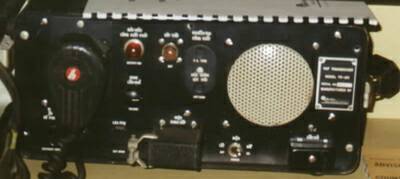Visit Pete's Home Page at www.militaryradio.com/spyradio!
The "Village Radios"
The "Village Radio Program" was sponsored by the CIA during the Vietnam conflict, through a front organization known as the Office of Public Safety (this series of radios are also known as "OPS radios"). The purpose was to provide simple radios to the local civilians, so that they could inform officials of Viet Cong activities. The radios were built under contract with Radio Industries (a subsidiary of Hallicrafters, purchased in 1963), and included the HT-1, the HT-2, the TR-5 "Hamlet Radio", and the TR-20 "Village Radio", among others. HT-1 units that have come into surplus channels recently are unmarked - earlier units have ID plates. Radios in the OPS series were used in other places in addition to Southeast Asia.

An
HT-1E handheld transceiver. Author's collection.
The case of the HT-1 is made of a piece of extruded aluminum, with a cap-plate on each end. The bottom plate covers the battery compartment, which contains 8 "D" cells. The radio operates from 30-40 MC AM, crystal-controlled on a single channel, with a power output of 0.5 watts. Input power is 12 VDC, 0.18 amps (transmit). Several versions were made, including the HT-1A through HT-1E.
Early versions of the HT-1 had a "destruct button" near the bottom of the case, near the antenna base. This button did not detonate an explosive; rather, pressing the button and the PTT switch at the same time would blow a 125 mA fuse on the circuit board, thus rendering the radio inoperable by disabling both the audio driver and transmit oscillator stages. In the field, users had instructions that if they were ever out of radio contact that they should return to base. So, when a user became nervous in the jungle, he would sometimes "destruct" his radio, so that he had a good excuse to return to the village. For this reason, the destruct button was eliminated from later models. The internal fuse was replaced with a wire. The HT-1A manual says that the destruct circuit was not included on all radios. The schematic indicates the wiring changes if the button is present. By the time of the HT-1E, the destruct button is mentioned only in the disassembly procedure (probably erroneously) the wiring for the button is gone from the schematic. [Note: The HT-1E schematic is missing a connection that is required for the transmit oscillator. This connection was probably removed by mistake when the destruct circuit was being removed.]
The HT-2 is a dual-band version of the HT-1. The TR-5 "Hamlet Radio" probably has a power output of about 5 W (no other info known at this time).

An HT-2, with dual-band capability. Image courtesy
of Bill Howard.
The TR-20 "Village Radio" is a hybrid tube/transistor "base station" transceiver with a 20 watt output, and it operates from 30-40 MC. It has a Destruct button similar to the early HT-1 which, when pressed, blows a concealed fuse. The TR-20's front panel is labeled in both English and Vietnamese.

A TR20 transceiver. Image courtesy of Bill Howard.
For more information on Clandestine Radios produced by the US, visit Pete McCollum's Clandestine Radio Page at www.militaryradio.com/spyradio.

HOT LINKS:
Home
|
Search QTH.NET Lists
|
Blast from the Past
|
Photo Archive
|
For Sale/Swap
Click here
to contact webmaster.
Click here
if there is no left-side menu frame.
This page last updated 30 Nov 2024

